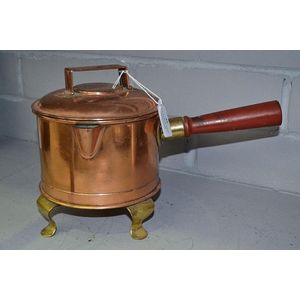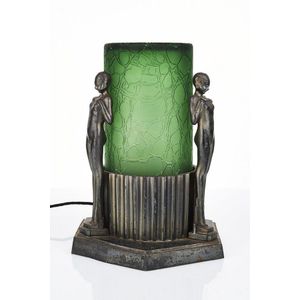Georgian Sterling Silver Three Piece Teaset
You must be a subscriber, and be logged in to view price and dealer details.
Subscribe Now to view actual auction price for this item
When you subscribe, you have the option of setting the currency in which to display prices to $Au, $US, $NZ or Stg.
- Sterling Silver - Sterling silver is a mixture of 92.5% pure silver and 7.5% of another metal, usually copper. Fine silver is 99.9% pure silver, and is relatively soft and the addition of the very small amount of copper gives the metal enough strength and hardness to be worked into jewellery, decorative and household objects.
- George V - George V (1865 ? 1936) was King of the United Kingdom and the British Dominions, and Emperor of India, from 1910 until his death in 1936.
- Finial - An architectural decoration, found on the upper parts of of an object. On furniture they are usually found on pediments, canopies and shelf supports. On smaller ceramic or silver items, such as spoons, they may decorate the top of the item itself, or the lid or cover where they provide a useful handle for removal.
Finials have a variety of shapes and forms. They may be urn-shaped, baluster shaped round or spiral, but usually taper into an upper point. Many real life shapes may also be used as finials, such as pineapples, berries, pinecones, buds, lotus and acorns. Sometimes animals such as a lion are depicted, or fish and dolphins. - Hallmarks - A mark stamped on articles of precious metals in Britain, since the 14th century, certifying their purity. It derives its name from the Guild Hall of the Goldsmiths' Company, who recieved its Charter in 1327 giving it the power to assay (test the purity) and mark articles of gold and silver.
The hallmark will consist of several marks, including the:
- silver standard mark, indicating the purity of the metal. Sterling silver is .925 pure silver.
- the city mark indicating the city in which it was assayed eg London, Birmingham, York etc.
- the date mark, usually a letter of the alphabet in a particular font and case,
- a duty mark, indicating whether duty had been paid to the crown, and only in use from 1784 to 1890
The piece may include an additional mark, the maker's mark, although not forming part of the hallmark, will be located in the vicinity of the hallmarks.
Sometimes silver plated items will bear faux hallmarks, often confusing those not familiar with silver markings.
This item has been included into following indexes:
- tea sets/services
Visually similar items

English hallmarked sterling silver Victorian three piece tea set comprising a hinged lid teapot, sugar & creamer, having a half fluted square form body with a timber handle & finial, engraved 'Presented to the Revd. F.H. & Mrs Waller on leaving Humshaugh b

Rare Sargison silver teapot, 13 cm high

Arts and craft copper and brass electric saucepan, painted wood handle, tin lined

Louise Cross Fort Franckart, American Art Deco table lamp, Debutante series, c. 1931, with green frosted crackle glass shade, depicting three female nudes standing on a hexagonal base, impressed 'Franckart. Inc. Pat. Des. D36200', height 29 cm. Provenance:
